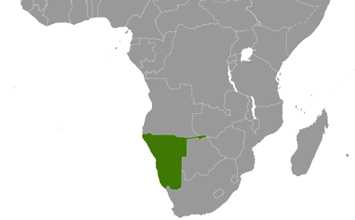Namibia has one of the world’s highest HIV prevalence rates. The 2013 Demographic and Health Survey reported a national adult population prevalence of 14% and as high as 23.7% in one of the regions. There is a disproportionate distribution of prevalence between women (16.9%) and men (10.9%) aged 15-49. There are an estimated 217,000 people living with HIV in Namibia, and 166,000 (76%) of those individuals are receiving antiretroviral therapy.
Prevention
CDC provides technical assistance to the MoHSS and partners to implement evidence-based prevention activities including PMTCT, voluntary medical male circumcision, ARV-based HIV prevention interventions (ART, PEP and PrEP), and HIV counseling and testing.
Key achievements and activities include:
- Previously, approximately 30% of babies born to HIV positive mothers were being infected with HIV. Today less than 5% of babies born to HIV positive mothers become infected.
- CDC is supporting efforts to reach men through the piloting of multi-disease screening outreach initiatives.
- CDC is planning for the roll out of HIV and gender based violence risk reduction activities in two districts with the intention of targeting nearly 20,000 young girls aged 10-24.
Care and treatment
Through PEPFAR support, CDC provides technical assistance for the continuum of care to infected and affected adults and children via health facilities and community-based organizations. Namibia has adopted the WHO 2016 antiretroviral therapy guidelines. The initiation of treatment regardless of CD4 count or clinical stage will improve the survival rate of people living with HIV/AIDS and decrease HIV transmission to HIV un-infected partners.
Key achievements and activities include:
- Support to the MoHSS to roll out over 50 community-based
ART clinics.
- More than 85% of patients on treatment have access to viral load testing and more than 87% of patients on treatment are virally suppressed.
- More than 90% of patient on treatment are retained. This has been achieved through intensive patient support including tracing patients lost to follow up.
In 2017, Namibia launched the Namibia Population-based HIV Impact Assessment Survey (NAMPHIA). The goal of the survey is to examine the current distribution of the HIV epidemic and assess the impact of Namibia’s prevention, care and treatment response across all 14 regions of Namibia. The survey is funded by PEPFAR through CDC.
Tuberculosis Activities
CDC also supports comprehensive TB/HIV activities in Namibia, including improving and integrating TB and HIV services for coinfected individuals, providing isoniazid preventative therapy for all eligible HIV-positive individuals, and supporting TB infection control efforts in healthcare facilities. CDC is also providing technical assistance for Namibia’s first national TB disease prevalence survey, which will measure TB prevalence using a population-based survey.
Impact in Namibia
- 97% of HIV-positive women during antenatal care received antiretroviral therapy for prevention of mother-to-child transmission of HIV.
- Antiretroviral therapy provided to 68% of adults and >90% of children in need
- 97% of HIV positive patients screened for TB in HIV care and treatment settings 100% of blood donations screened for HIV
- National laboratory networks supported enabling improved disease detection and response
- As of 2015, Namibia’s TB treatment success rate is 85%.
- The proportion of people in Namibia who are diagnosed with active TB disease who also know their HIV status increased from 30% to >95% between 2006 and 2016.







 ShareCompartir
ShareCompartir

